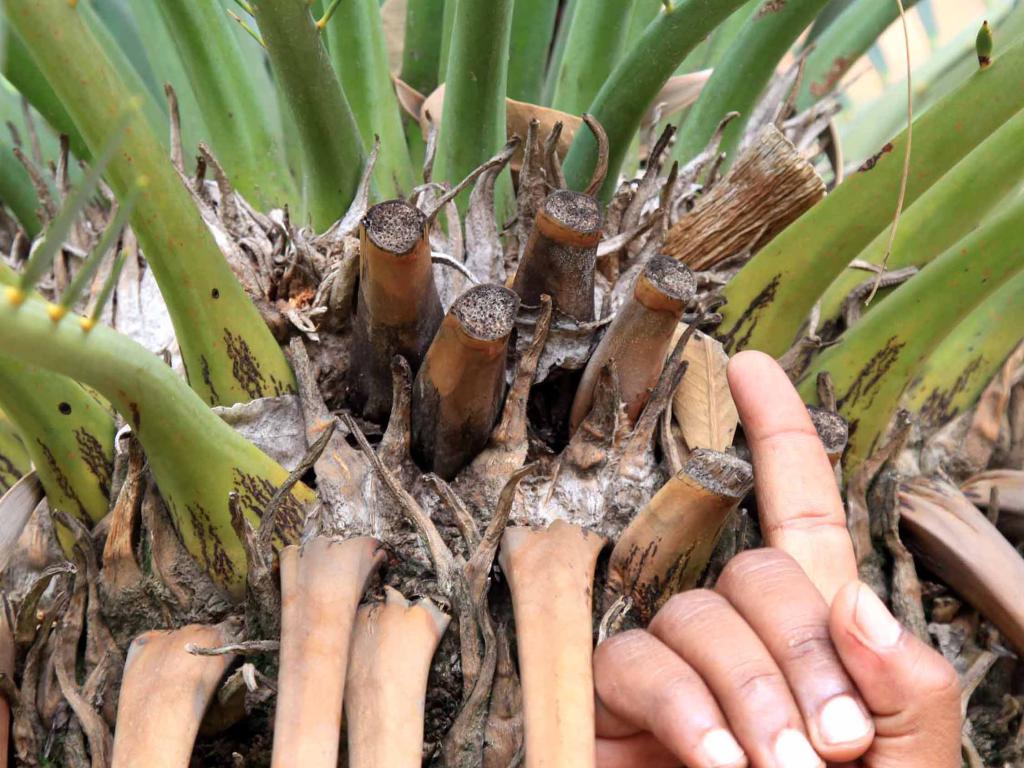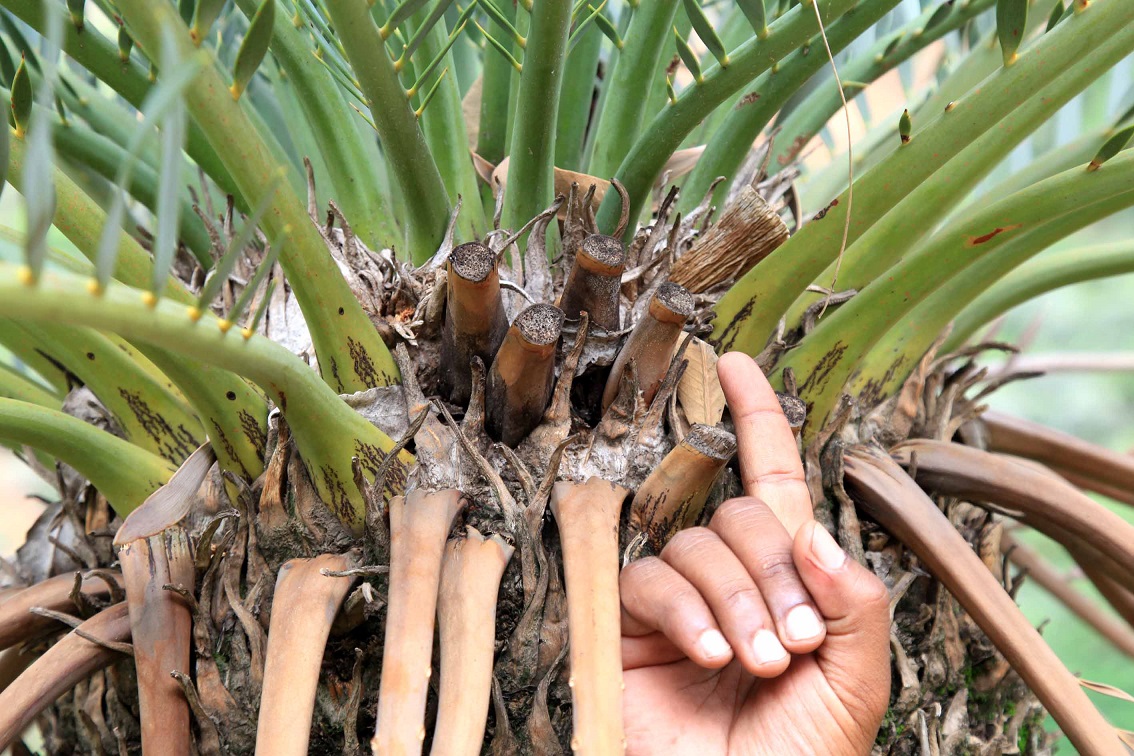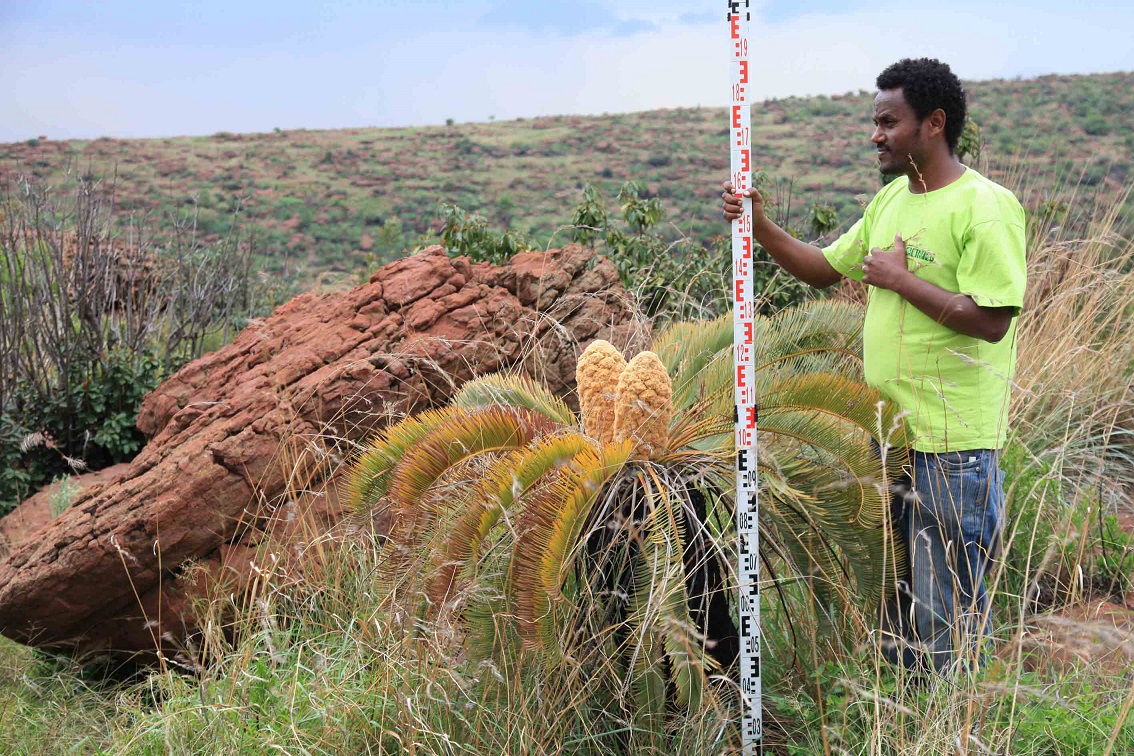The Land of Cycads – Repeat photo fieldtrip to the north-eastern part of South Africa


Evidence that the outer leaves of this Encephalartos middelburgensis were removed to access the valuable female cone. It is unclear what impact removal of seed has on the long-term survival of cycad populations (Photo: S. Jack)
After completing all the cycad repeat photos within the Eastern Cape and KwaZulu-Natal, it was time to cover the last two remaining provinces - namely Mpumalanga and Limpopo – before 2014 came to a close. After rephotographing a small population of E. lanatus near Bronkhorstspruit we moved on to Middelburg where we spent a few days recording a much larger and generally healthy stand of the same species. We then moved north to the Loskop Dam area where we found a small and isolated population of immense E. middelburgensis individuals. We were again impressed by the adventurous spirit of R.A. Dyer, who took the original image in this rugged, seemingly pristine and secluded environment. The trees were on fairly steep and inaccessible ground, but after clambering to them we found clear cut marks on a female cycad, which we suspect may have been an attempt to remove the spikey leaves before accessing the female cone. It seems there is no place to hide if you’re a cycad with valuable seeds.
After a day-off sampling the excellent rock climbing at Waterval Boven (it would’ve been rude not to!), we headed towards the Berlin Plantation managed by Komatiland Forests and met up with Chris Foster – the environmental control officer for that section. Unfortunately the cycads we were looking for – very tall E. laevifolius – were long gone. Chris assured us that there were plants remaining in adjacent valleys and showed us photos of individuals that he’d taken during his own monitoring. However, he conceded that poaching was ongoing and that he didn’t have the manpower to protect the remaining trees. The excellent weather we’d experienced until that point then gave in and we spent a frustrating couple of days at a campsite near the Sudwala Caves, venturing out for brief spells to locate and rephoto old photos of E. humilis. Our efforts were greatly aided by a local farmer, Simon Dunshea, whom De Wet Bosenberg managed to put us in touch with. He knew the lay of the land and various landowners and quickly figured out where two of the three images were located. Unfortunately we listened to Simon recount how, about 4 years ago, a large population of several hundred E. humilis individuals were removed from the area. (About a hundred were left behind as the truck transporting the plants was presumably too full to accommodate them). Another populations wiped out. Eish.
Then it was time to head north to the Land of the Rain Queen, Modjadji. We passed some magnificent scenery along the way (Mac-Mac Falls, God’s Window, World’s End, JG Strydom Tunnel). This part of the country is definitely worth a return visit! The density of cycads at Modjadji is something to behold. Wandering on footpaths beneath these old giants, it’s not a stretch to imagine that one has time-travelled to the age of the dinosaurs when cycads were more prolific. The sheer size of the stems, leaves and cones of E. transvenosus dwarfed all the other cycad species we’d previously encountered. The cycad reserve has some great potential but is sadly run down and probably underutilized by tourists because of this.
Our last cycad repeats were atop the Soutpansberg outside of Louis Trichardt. The low-range gearing on the Mazda Wildlife Vehicle was put to test crawling up the comically steep track leading up the mountain…and thankfully passed the test admirably. The larger E. transvenosus specimens in the original image had all died, presumably due to a severe and prolonged drought in the mid-nineties, but there were many healthy recruits which were gradually pushing their way up through the tangled undergrowth. If conditions remain favourable in years to come, these hardy plants will again stand proud on the edge of the Soutpansberg.
Now that all the repeats have been retaken and the crew are safely back home, the work of matching and interpreting the patterns of change seen in the photos begins. Watch this space as the South African cycad story takes shape!
Article by Desale Y Okubamichael & Sam Jack

Desale in the field next to Female Encephalartos middelburgensis in cone (Photo S. Jack)
